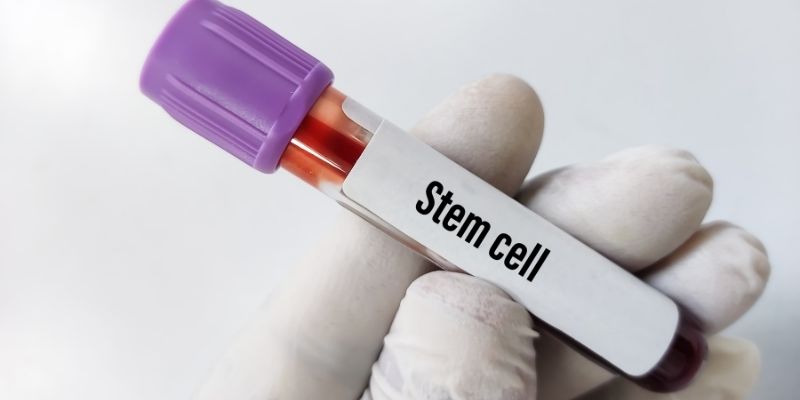Stem Cell Transplants for Scleroderma: High Risk, High Reward Treatment
The danger of stem cell transplantation for scleroderma is significant, yet they may be beneficial in severe instances. Autoimmune scleroderma stiffens skin and joints. It might significantly impact health and life. Since there are few treatments, individuals should learn about new ones like stem cell transplantation.

Know the Problems with Scleroderma
Scleroderma, or systemic sclerosis, is a complicated autoimmune disease that impacts more than just the skin. It is better for people with restricted scleroderma, which affects the skin. The heart, lungs, and kidneys are quickly hurt by diffuse scleroderma. Both kinds make too much collagen, which is terrible for the body and makes skin thicker. This makes life worse.
Nobody knows what causes scleroderma, but an immune system that doesn't work right leads to too much collagen and scarring. This makes skin thicker, and organs work less well. Joint pain, tiredness, trouble eating, and shortness of breath are common symptoms. Medication is mainly used to control symptoms, not the illness itself. Different treatments are needed because the condition can appear in various ways.
Traditional approaches have flaws.
Cyclophosphamide and methotrexate treat scleroderma. Anti-inflammatory drugs that delay sickness... However, these therapies may fail or be harmful. Because many patients don't respond to current therapies, better ones are needed. Long-term immunosuppressant usage increases the risk of infections and other issues, making therapy difficult.
Stem cell transplants may treat severe scleroderma. Patient stem cells "reset" the immune system and improve health. This new cancer therapy is still under development, but early testing suggests it may help, attracting attention and investment.
Stem cell transplantation sounds promising.
Autologous stem cell transplantation improves scleroderma. Blood stem cells are collected from the patient's bone marrow or peripheral blood. The patient then receives high-dose chemotherapy and radiation to suppress their immune system. Preparation is complex, yet it is vital to eliminate disease-causing biological responses.
After cleaning, the patient's stem cells rebuild the immune system. Scleroderma patients produce too much collagen; thus, the new defensive mechanism should function. Human studies suggest HSCT may improve skin, lungs, and quality of life. Because the therapy might induce disease and organ damage, individuals must be carefully selected and monitored.
Lab proof that HSCT works
New studies show that HSCT can help people with severe scleroderma. A significant research study called Scleroderma: Cyclophosphamide or Transplantation (SCOT) looked at the differences between HSCT and cyclophosphamide for people with diffuse scleroderma and lung or kidney problems.
In the long run, HSCT worked better than cyclophosphamide. 79% of people who had HSCT said they had no significant problems after four and a half years. There were no problems for half of the people who took cyclophosphamide. Only 9% needed extra immunosuppressants after HSCT, compared to 44% who needed them during usual care.
The results show that HSCT improves life and increases the chance of survival for people with severe scleroderma. Cutting down on long-term immunosuppressant use might be good for health. According to clinical studies, HSCT may change how this painful condition is treated.
Risks with stem cell treatments
It's essential to know about the risks of HSCT, but it also has many benefits. For people who train before they donate, it could lead to infections, low blood cell counts, and liver damage. Some people may have weaker immune systems, which makes them more likely to get sick.
Some study volunteers said that the drugs they were taking had terrible side effects. The SCOT study showed that HSCT was linked to deaths. People considering this choice should talk to their doctors about these worries. If you know about the harmful effects, you can plan and make wise decisions.
Long-term risks include getting cancer again or not being able to have children. While HSCT has many benefits, these possible problems show why the risks and rewards must be carefully weighed and the patient must be closely watched before and after treatment.
Criteria used to pick people
The correct persons must be chosen for HSCT since it is risky. Many severe scleroderma patients who haven't responded to prior therapies might benefit from this. Profound organ loss may hinder organ transplants. Doctors evaluate patients' health and hazards before recommending HSCT. Age, health, and illness severity determine who may acquire this high-risk drug. Mixing teams is typically the best approach to handle all patient issues.
Psychosocial aspects are considered while selecting patients. Though difficult, HSCT requires emotional and mental health support. Evaluations prepare individuals for treatment and recovery.

What's Next for Stem Cell Therapy for Scleroderma?
With more studies, sclerosis stem cell treatment might get better and safer. Researchers are investigating whether training plans and stem cell sources can improve the treatment results. Learning more about scleroderma could help us develop better treatments than HSCT. More research is being done on new stem cell transplant drugs to make them safer and more effective. Individualized medicine might make care better by making treatments work better. Gene editing and stem cell harvesting are two new methods that could change how the work is done. Improvements in HSCT may help patients do better.
How and what a patient feels
Different scleroderma people have different HSCT experiences. Some people felt better and had better quality of life after therapy. Many people with successful transplants no longer have skin growth or joint pain.
Share your best scleroderma stories to help other people. HSCT patients can share their stories online in support groups and platforms. Many of these stories are about mental and emotional health care meant to give newbies hope and support. HSCT patients may benefit from the community and information these personal stories offer.
Conclusion:
Stem cell therapy for severe scleroderma may be hazardous yet effective. Traditional therapies may not assist many, while HSCT may improve mortality and quality of life. People considering this procedure should speak to their physicians since research continually improves methods and lowers dangers. When traditional treatments fail, stem cell therapy provides scleroderma patients hope. Before initiating this new therapy, patients may weigh the advantages and drawbacks.












